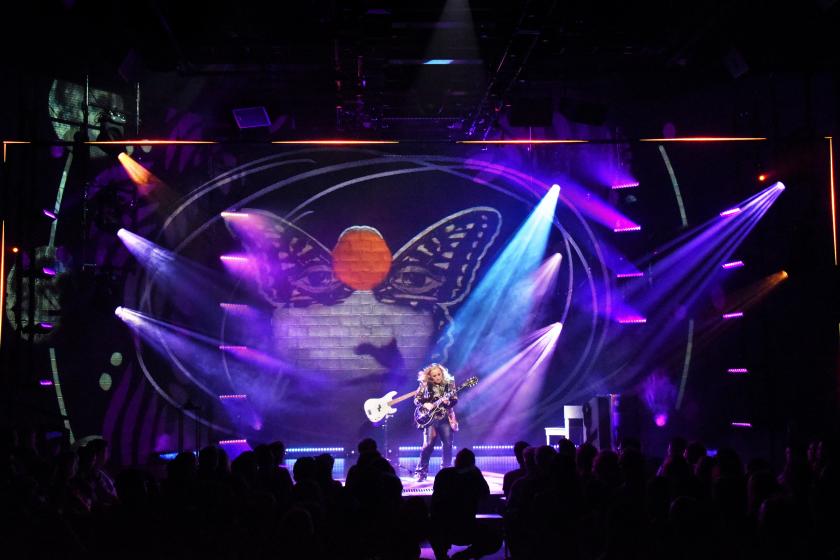How High-Tech Projection Design Powers Immersive Entertainment ExperiencesHow High-Tech Projection Design Powers Immersive Entertainment Experiences
Lars Pedersen, a leading stage and lighting equipment executive behind major theater productions and live acts since 1979, explains the infrastructure required to bring complex visual displays to large-scale shows.
December 26, 2023

For major entertainment productions, video equipment configurations can comprise a single projector, a linear LED wall, multiple projectors like in the immersive Van Gogh art exhibit, or millions of pixels as seen in the Sphere in Las Vegas.
“You’re able to create a large seamless image,” says Lars Pedersen, vice president of project innovation at 4Wall Entertainment, a company that provides audio, lighting, and video equipment rentals. Pedersen has been working behind the scenes in the entertainment industry since 1979.
In the entertainment industry, equipment rental providers often manage the IT aspects of a production.
Projection designer Olivia Sebesky, who has designed a wide range of entertainment shows, from Aerosmith and Carrie Underwood performances to the visual designs in Broadway’s Melissa Etheridge: My Window, works with 4Wall to decide how many projectors they need to feed a signal to computers and how many computers can make a production design come to life.
Sebesky built a relationship with the 4Wall team and has collaborated with them on the tech aspects of projection her entire career, including the Etheridge Broadway show, she says.
“That would be my preference to always have that [4Wall] team working with me, because then I know the technology is correct,” Sebesky says. “And it will be working, and they'll be supportive throughout the whole process.”
When Pedersen receives requests from projection designers or technical directors for a particular show, his team will configure a package of equipment that meets their requirements. They create a content template or pixel map to allow a projection designer to create content according to the desired resolution.
Projection teams distribute lighting using Art-Net protocol, and instructions get sent from a programming console to lighting instruments throughout a venue.
“You can imagine how many different places that Art-Net protocol needs to go to within the theater, and that's typically distributed over Ethernet cable, Cat cable, or fiber,” Pedersen says in an interview.
Wired Signals Connect Entertainment Lighting Productions
A wired signal rather than a wireless connection sends visual displays to the big screens at a live event. Although some handheld cameras moving about the stage distribute wireless signals, the large video displays at shows have too much bandwidth to distribute all content wirelessly, according to Pedersen.
He suggests that venues’ security concerns of users tapping into a network may be a reason why productions send signals to media servers over wired connections.
“That's a danger signal,” Pedersen says. “I think we need to get past that, which I don't think will be a difficult thing to do once people feel more comfortable.”
Separate Teams Manage the Infrastructure for Live Acts
Although larger venues might have their own IT directors, a theater production such as the Etheridge Broadway show consists of a collaborative effort rather than having a single IT director or CIO, according to Pedersen. In fact, video engineers double as networking personnel.
However, when Pedersen works with the Metropolitan Opera in New York City, the opera house has its own IT team, he says.
Pedersen would like to see entertainment productions hire a dedicated networking team.
“I don't think we're quite there yet, so that responsibility is shared among the various technicians within the different departments,” Pedersen says.
Sebesky sees the relationship between design teams and IT as a “push-pull” collaboration as far as brainstorming on what might work, such as projectors with particular lens and mirror technology.
Production teams for shows bring their own media servers to a venue, but a venue might have its own infrastructure to distribute network signals throughout the facility, according to Pedersen.
“Content that someone like [Sebesky] would create for a particular show eventually ends up on these media servers and is then programmed,” Pedersen explains. “The media servers are programmed accordingly depending on what needs to be displayed or shown during the show.”
Audio, lighting, video, and props all handle their own networking connections.
“We are certainly moving quickly toward a world in the live event industry where all of the various disciplines—audio, video, lighting, for example—live on this network topology, and rather than being separate islands that are part of this overall show presentation, they're all connected and working seamlessly together,” Pedersen says.
He sees a need for technology similar to how observability software works, in which the networking tool could spot abnormalities and raise a red flag if a projector, fiber line, or media server has failed.
“I think it'll be easier to address if everything is on the same network,” Pedersen says. “The reaction time will be much quicker.”
A central networking department or a main CIO or IT leader would help make the networking connections run even more smoothly. However, the tech leader for a production would need to fit into a show’s budget, he notes.
“I think that will go a long way to realizing this goal of everybody living on the network,” Pedersen says.
About the Author
You May Also Like




